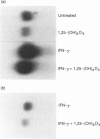Abstract
The regulatory activity of 1,25-dihydroxyvitamin D3 (1,25-(OH)2D3) on human leucocyte antigen (HLA)-DR (MHC class II) antigen expression in monocytes from normal human peripheral blood was examined. Using forward light and side scatter by flow cytometry most cells within the discrete monocyte area expressed high levels of HLA-DR antigens following 4-day culture in medium alone (culture-enhanced HLA-DR) and expression was further up-regulated in the presence of interferon-gamma (IFN-gamma) (IFN-gamma-enhanced HLA-DR). Treatment with 1,25-(OH)2D3 markedly inhibited both culture and IFN-gamma-enhanced HLA-DR but not HLA-ABC (MHC class I). This 1,25-(OH)2D3 inhibition was as effective as PGE2 and hydrocortisone. To ascertain if HLA-DR was specifically down-regulated on monocytes, the effect of vitamin D3 analogues in CD33+ cells was examined. Incubation of the CD33+ cells with 1,25-(OH)2D3, 24-25-(OH)2D3 and 25-OHD3 resulted in dose-dependent inhibition of culture-enhanced HLA-DR paralleling the vitamin D3-receptor affinities of these compounds. Northern analysis also demonstrated that 1,25-(OH)2D3 treatment markedly decreased both expression of culture-enhanced and IFN-gamma-enhanced HLA-DR beta chain messenger RNA (mRNA) in monocyte-enriched populations. In total, our findings are consistent with the proposal that vitamin D3 analogues can contribute to down-regulating immune responses as a consequence of inhibiting class II expression.
Full text
PDF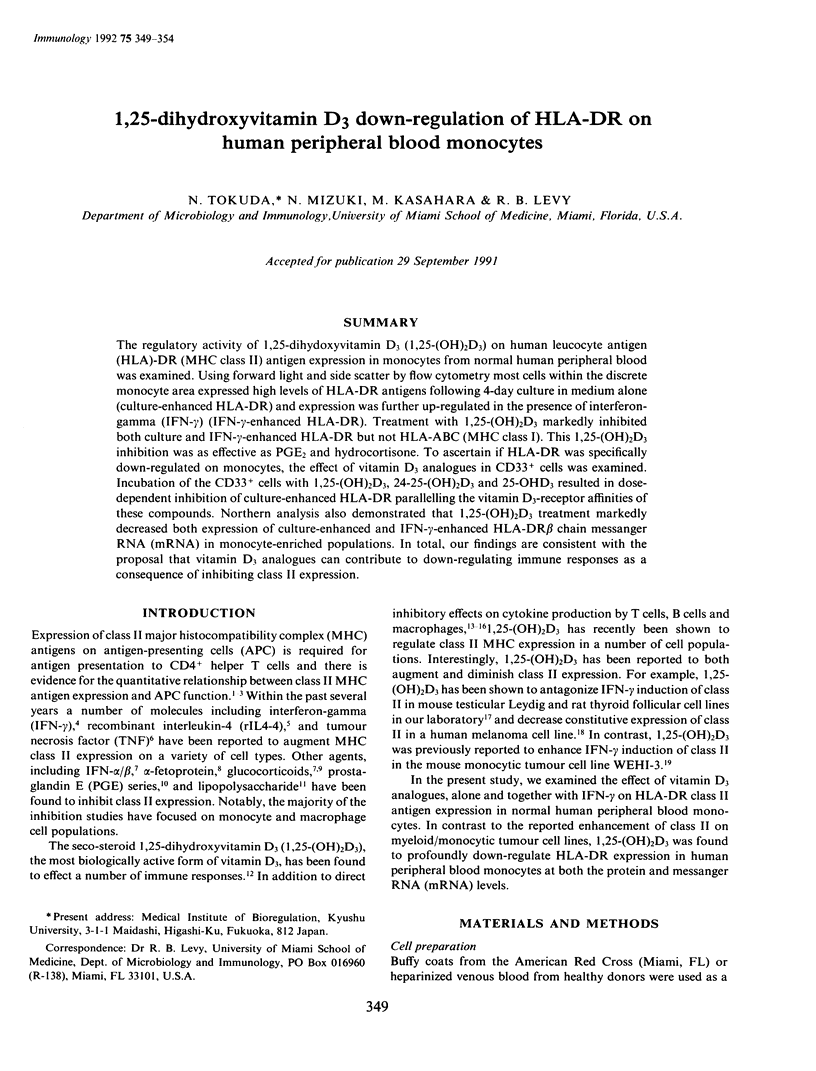
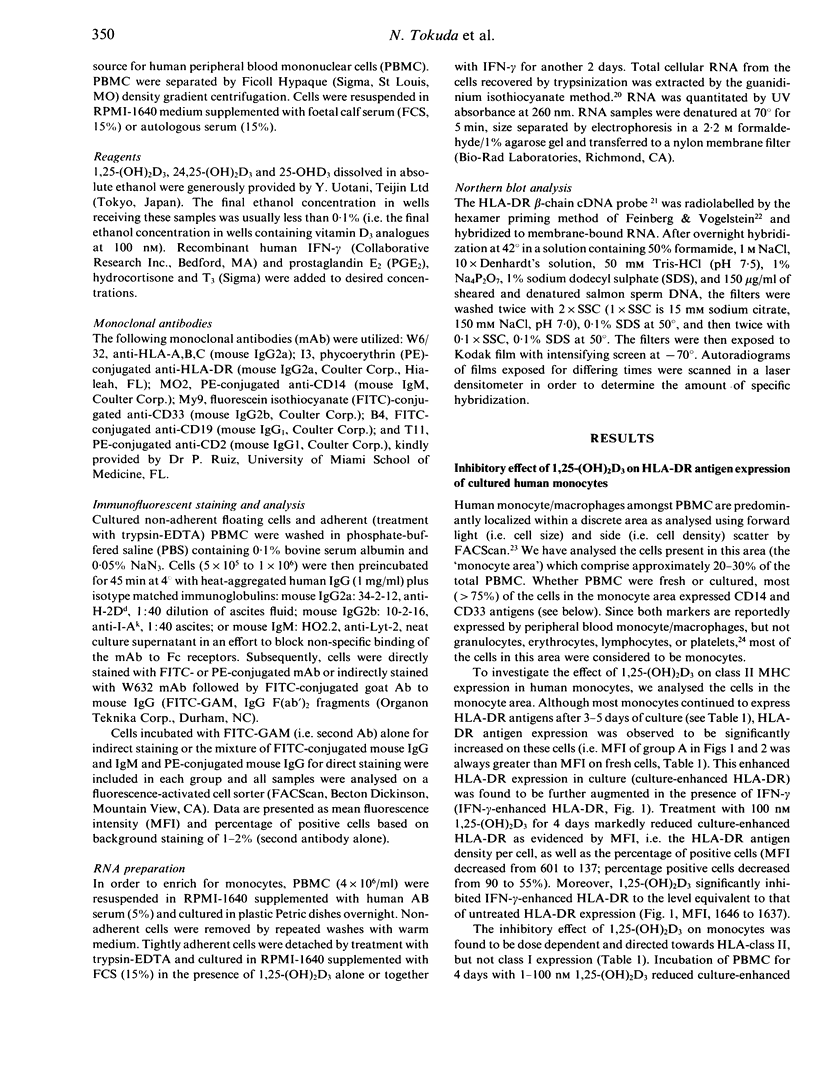
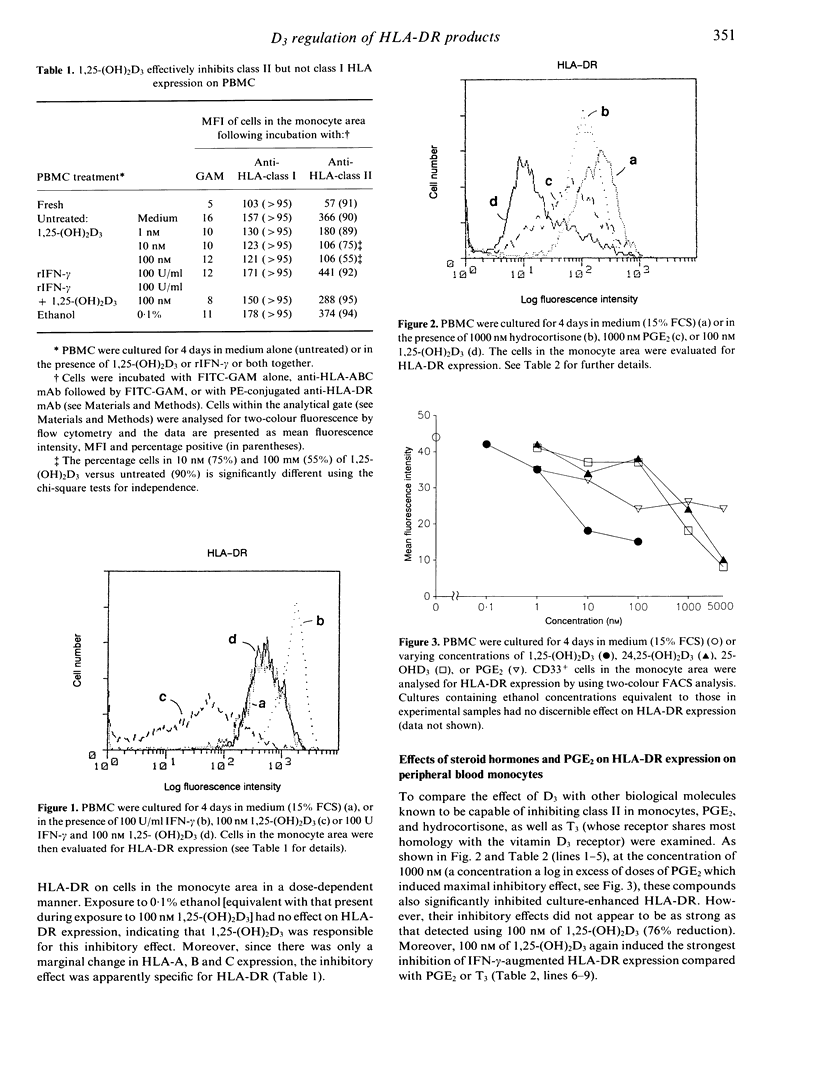
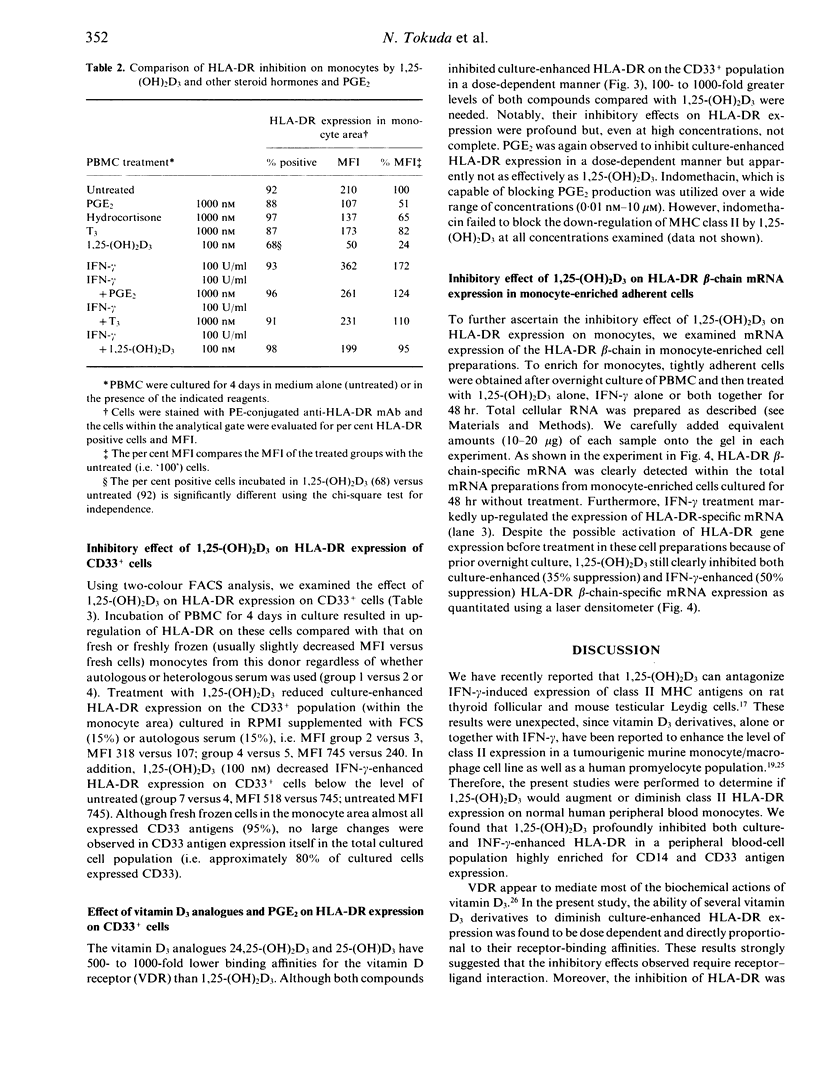

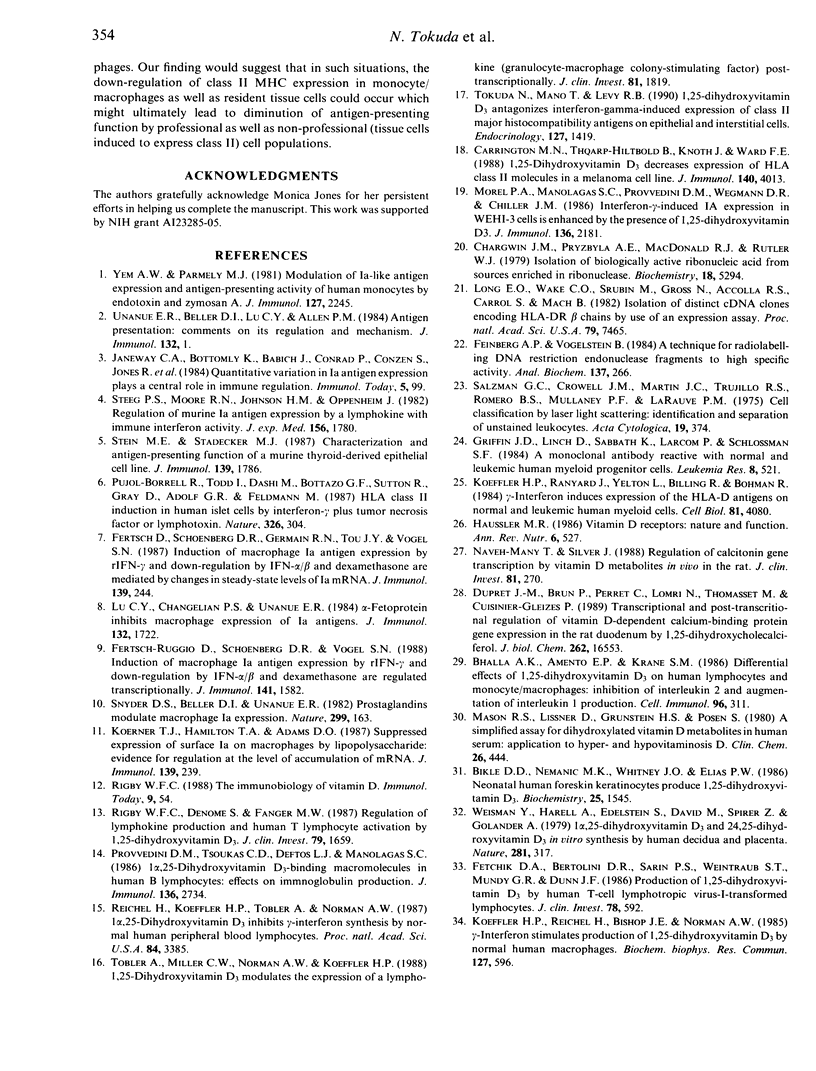
Images in this article
Selected References
These references are in PubMed. This may not be the complete list of references from this article.
- Bhalla A. K., Amento E. P., Krane S. M. Differential effects of 1,25-dihydroxyvitamin D3 on human lymphocytes and monocyte/macrophages: inhibition of interleukin-2 and augmentation of interleukin-1 production. Cell Immunol. 1986 Apr 1;98(2):311–322. doi: 10.1016/0008-8749(86)90291-1. [DOI] [PubMed] [Google Scholar]
- Bikle D. D., Nemanic M. K., Whitney J. O., Elias P. W. Neonatal human foreskin keratinocytes produce 1,25-dihydroxyvitamin D3. Biochemistry. 1986 Apr 8;25(7):1545–1548. doi: 10.1021/bi00355a013. [DOI] [PubMed] [Google Scholar]
- Carrington M. N., Tharp-Hiltbold B., Knoth J., Ward F. E. 1,25-Dihydroxyvitamin D3 decreases expression of HLA class II molecules in a melanoma cell line. J Immunol. 1988 Jun 1;140(11):4013–4018. [PubMed] [Google Scholar]
- Chirgwin J. M., Przybyla A. E., MacDonald R. J., Rutter W. J. Isolation of biologically active ribonucleic acid from sources enriched in ribonuclease. Biochemistry. 1979 Nov 27;18(24):5294–5299. doi: 10.1021/bi00591a005. [DOI] [PubMed] [Google Scholar]
- Dupret J. M., Brun P., Perret C., Lomri N., Thomasset M., Cuisinier-Gleizes P. Transcriptional and post-transcriptional regulation of vitamin D-dependent calcium-binding protein gene expression in the rat duodenum by 1,25-dihydroxycholecalciferol. J Biol Chem. 1987 Dec 5;262(34):16553–16557. [PubMed] [Google Scholar]
- Feinberg A. P., Vogelstein B. "A technique for radiolabeling DNA restriction endonuclease fragments to high specific activity". Addendum. Anal Biochem. 1984 Feb;137(1):266–267. doi: 10.1016/0003-2697(84)90381-6. [DOI] [PubMed] [Google Scholar]
- Fertsch-Ruggio D., Schoenberg D. R., Vogel S. N. Induction of macrophage Ia antigen expression by rIFN-gamma and down-regulation by IFN-alpha/beta and dexamethasone are regulated transcriptionally. J Immunol. 1988 Sep 1;141(5):1582–1589. [PubMed] [Google Scholar]
- Fertsch D., Schoenberg D. R., Germain R. N., Tou J. Y., Vogel S. N. Induction of macrophage Ia antigen expression by rIFN-gamma and down-regulation by IFN-alpha/beta and dexamethasone are mediated by changes in steady-state levels of Ia mRNA. J Immunol. 1987 Jul 1;139(1):244–249. [PubMed] [Google Scholar]
- Fetchick D. A., Bertolini D. R., Sarin P. S., Weintraub S. T., Mundy G. R., Dunn J. F. Production of 1,25-dihydroxyvitamin D3 by human T cell lymphotrophic virus-I-transformed lymphocytes. J Clin Invest. 1986 Aug;78(2):592–596. doi: 10.1172/JCI112614. [DOI] [PMC free article] [PubMed] [Google Scholar]
- Griffin J. D., Linch D., Sabbath K., Larcom P., Schlossman S. F. A monoclonal antibody reactive with normal and leukemic human myeloid progenitor cells. Leuk Res. 1984;8(4):521–534. doi: 10.1016/0145-2126(84)90001-8. [DOI] [PubMed] [Google Scholar]
- Haussler M. R. Vitamin D receptors: nature and function. Annu Rev Nutr. 1986;6:527–562. doi: 10.1146/annurev.nu.06.070186.002523. [DOI] [PubMed] [Google Scholar]
- Koeffler H. P., Ranyard J., Yelton L., Billing R., Bohman R. Gamma-interferon induces expression of the HLA-D antigens on normal and leukemic human myeloid cells. Proc Natl Acad Sci U S A. 1984 Jul;81(13):4080–4084. doi: 10.1073/pnas.81.13.4080. [DOI] [PMC free article] [PubMed] [Google Scholar]
- Koeffler H. P., Reichel H., Bishop J. E., Norman A. W. gamma-Interferon stimulates production of 1,25-dihydroxyvitamin D3 by normal human macrophages. Biochem Biophys Res Commun. 1985 Mar 15;127(2):596–603. doi: 10.1016/s0006-291x(85)80202-3. [DOI] [PubMed] [Google Scholar]
- Koerner T. J., Hamilton T. A., Adams D. O. Suppressed expression of surface Ia on macrophages by lipopolysaccharide: evidence for regulation at the level of accumulation of mRNA. J Immunol. 1987 Jul 1;139(1):239–243. [PubMed] [Google Scholar]
- Long E. O., Wake C. T., Strubin M., Gross N., Accolla R. S., Carrel S., Mach B. Isolation of distinct cDNA clones encoding HLA-DR beta chains by use of an expression assay. Proc Natl Acad Sci U S A. 1982 Dec;79(23):7465–7469. doi: 10.1073/pnas.79.23.7465. [DOI] [PMC free article] [PubMed] [Google Scholar]
- Lu C. Y., Changelian P. S., Unanue E. R. Alpha-fetoprotein inhibits macrophage expression of Ia antigens. J Immunol. 1984 Apr;132(4):1722–1727. [PubMed] [Google Scholar]
- Mason R. S., Lissner D., Grunstein H. S., Posen S. A simplified assay for dihydroxylated vitamin D metabolites in human serum: application to hyper- and hypovitaminosis D. Clin Chem. 1980 Mar;26(3):444–450. [PubMed] [Google Scholar]
- Morel P. A., Manolagas S. C., Provvedini D. M., Wegmann D. R., Chiller J. M. Interferon-gamma-induced IA expression in WEHI-3 cells is enhanced by the presence of 1,25-dihydroxyvitamin D3. J Immunol. 1986 Mar 15;136(6):2181–2186. [PubMed] [Google Scholar]
- Naveh-Many T., Silver J. Regulation of calcitonin gene transcription by vitamin D metabolites in vivo in the rat. J Clin Invest. 1988 Jan;81(1):270–273. doi: 10.1172/JCI113305. [DOI] [PMC free article] [PubMed] [Google Scholar]
- Provvedini D. M., Tsoukas C. D., Deftos L. J., Manolagas S. C. 1 alpha,25-Dihydroxyvitamin D3-binding macromolecules in human B lymphocytes: effects on immunoglobulin production. J Immunol. 1986 Apr 15;136(8):2734–2740. [PubMed] [Google Scholar]
- Pujol-Borrell R., Todd I., Doshi M., Bottazzo G. F., Sutton R., Gray D., Adolf G. R., Feldmann M. HLA class II induction in human islet cells by interferon-gamma plus tumour necrosis factor or lymphotoxin. Nature. 1987 Mar 19;326(6110):304–306. doi: 10.1038/326304a0. [DOI] [PubMed] [Google Scholar]
- Reichel H., Koeffler H. P., Tobler A., Norman A. W. 1 alpha,25-Dihydroxyvitamin D3 inhibits gamma-interferon synthesis by normal human peripheral blood lymphocytes. Proc Natl Acad Sci U S A. 1987 May;84(10):3385–3389. doi: 10.1073/pnas.84.10.3385. [DOI] [PMC free article] [PubMed] [Google Scholar]
- Rigby W. F., Denome S., Fanger M. W. Regulation of lymphokine production and human T lymphocyte activation by 1,25-dihydroxyvitamin D3. Specific inhibition at the level of messenger RNA. J Clin Invest. 1987 Jun;79(6):1659–1664. doi: 10.1172/JCI113004. [DOI] [PMC free article] [PubMed] [Google Scholar]
- Rigby W. F. The immunobiology of vitamin D. Immunol Today. 1988 Feb;9(2):54–58. [PubMed] [Google Scholar]
- Salzman G. C., Crowell J. M., Martin J. C., Trujillo T. T., Romero A., Mullaney P. F., LaBauve P. M. Cell classification by laser light scattering: identification and separation of unstained leukocytes. Acta Cytol. 1975 Jul-Aug;19(4):374–377. [PubMed] [Google Scholar]
- Snyder D. S., Beller D. I., Unanue E. R. Prostaglandins modulate macrophage Ia expression. Nature. 1982 Sep 9;299(5879):163–165. doi: 10.1038/299163a0. [DOI] [PubMed] [Google Scholar]
- Steeg P. S., Moore R. N., Johnson H. M., Oppenheim J. J. Regulation of murine macrophage Ia antigen expression by a lymphokine with immune interferon activity. J Exp Med. 1982 Dec 1;156(6):1780–1793. doi: 10.1084/jem.156.6.1780. [DOI] [PMC free article] [PubMed] [Google Scholar]
- Stein M. E., Stadecker M. J. Characterization and antigen-presenting function of a murine thyroid-derived epithelial cell line. J Immunol. 1987 Sep 15;139(6):1786–1791. [PubMed] [Google Scholar]
- Tobler A., Miller C. W., Norman A. W., Koeffler H. P. 1,25-Dihydroxyvitamin D3 modulates the expression of a lymphokine (granulocyte-macrophage colony-stimulating factor) posttranscriptionally. J Clin Invest. 1988 Jun;81(6):1819–1823. doi: 10.1172/JCI113525. [DOI] [PMC free article] [PubMed] [Google Scholar]
- Tokuda N., Mano T., Levy R. B. 1,25-Dihydroxyvitamin D3 antagonizes interferon-gamma-induced expression of class II major histocompatibility antigens on thyroid follicular and testicular Leydig cells. Endocrinology. 1990 Sep;127(3):1419–1427. doi: 10.1210/endo-127-3-1419. [DOI] [PubMed] [Google Scholar]
- Weisman Y., Harell A., Edelstein S., David M., Spirer Z., Golander A. 1 alpha, 25-Dihydroxyvitamin D3 and 24,25-dihydroxyvitamin D3 in vitro synthesis by human decidua and placenta. Nature. 1979 Sep 27;281(5729):317–319. doi: 10.1038/281317a0. [DOI] [PubMed] [Google Scholar]
- Yem A. W., Parmely M. J. Modulation of Ia-like antigen expression and antigen-presenting activity of human monocytes by endotoxin and zymosan A. J Immunol. 1981 Dec;127(6):2245–2251. [PubMed] [Google Scholar]



